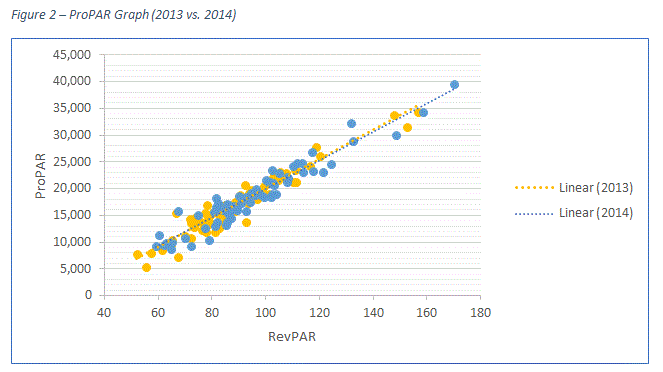ProPAR Graph
Earlier this year, Hotel Appraisers & Advisors published an article summarizing how several hundred hotels performed, ranked by House Profit per available room (ProPAR). The article then compared each hotel’s ProPAR level relative to Rooms Revenue per available room (RevPAR). By standardizing for RevPAR, the analysis allowed us to compare profitability of hotels of different service types, chain scales, and brands. This metric also allows owners to compare the performance of hotels managed by different management companies. By using ProPAR and RevPAR, HA&A showed a simple way of analyzing hotel profitability, while standardizing all variables that affect revenue.
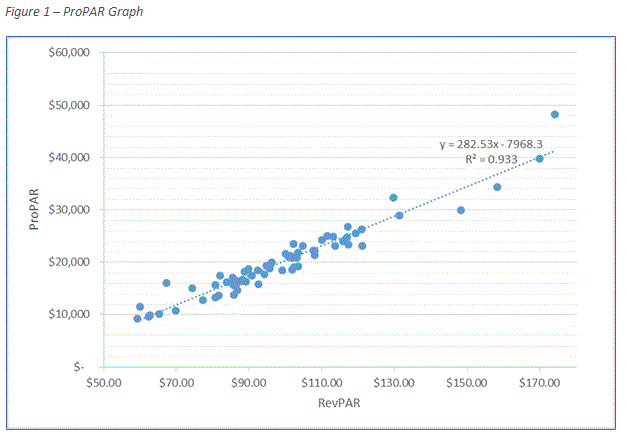
The scatter plot in the ProPAR graph above is constructed by using data of 70 branded, upscale hotels across the county. The scatter plot shows dots gathering tightly along a straight line, which is indicative of a strong linear relationship between RevPAR and ProPAR. This relationship can be expressed mathematically by the following two-variable linear equation:
ProPAR = RevPAR*β + α
In this equation α and β are constants that determine the interception on the y-axis and the slope of the regression line, respectively. In the preceding example, β is 282.53 and α is -7,968.3.
The following figure illustrates how the scatter plot shifted from 2013 to 2014 using the RevPAR and ProPAR data from the sample set.
Since most of the sample hotels experienced positive RevPAR and ProPAR growth between 2013 and 2014, we can see the dots shift in a right-upward direction, from yellow to blue. Yet, the two linear trend lines appear to closely match. This indicates that RevPAR and ProPAR of the sample set maintain their linear relationship regardless of changes in RevPAR and ProPAR levels over time.
In this article, we will illustrate examples of how we can analyze this graph and what we can learn about the relationship between RevPAR and ProPAR.
Deceleration of Profit Growth
The concept of diminishing marginal returns is taught in many micro economics classes. A company’s growth will decelerate as the company matures, or grows, and marginal profits decline. In this section, we show that we can infer a similar relationship between RevPAR and ProPAR from the ProPAR graph.
The following figure is created using the linear equation obtained from the earlier ProPAR graph. It shows how ProPAR growth rates change as RevPAR increases by a given amount, say 5.0%. When the RevPAR level is close to $60, ProPAR grew by roughly 9.5% per 5.0% increase in RevPAR. However, when the RevPAR level is close to $170, the ProPAR growth rate decreases to 6.0% per 5.0% increase in RevPAR. This data suggests that ProPAR growth rates decelerate as RevPAR levels increase.
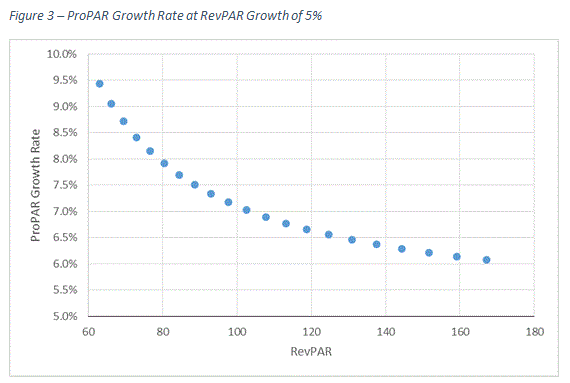
Another noticeable point from Figure 3 is that the decreases in the ProPAR growth rate become smaller as RevPAR levels become larger. At the beginning of the curve, the ProPAR growth rate decelerated by almost 0.5% per 5.0% increase in RevPAR while the ProPAR growth rate decelerated by less than 0.1% near the end of the curve. Is there a point where ProPAR ceases to decrease?
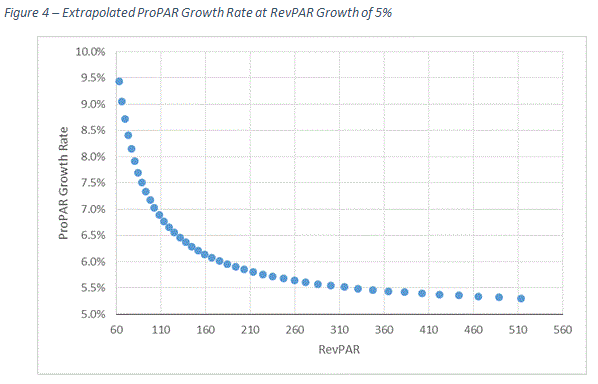
Figure 4 shows what will happen to ProPAR growth if we extrapolate the linear line far beyond our data set. It appears that the ProPAR growth rate is getting closer and closer to 5.0%, which is the RevPAR growth rate intervals we are using in this experiment. As shown later in this article, the curve will “converge” to 5.0% if we assume that we can extend the straight line beyond the data set we sued in our study.
Although the computation of hypothetical ProPAR growth rates loses its relevancy in the real world once RevPAR exceeds realistic levels, the idea that the ProPAR growth rate approaches the RevPAR growth rate has an interesting implication.
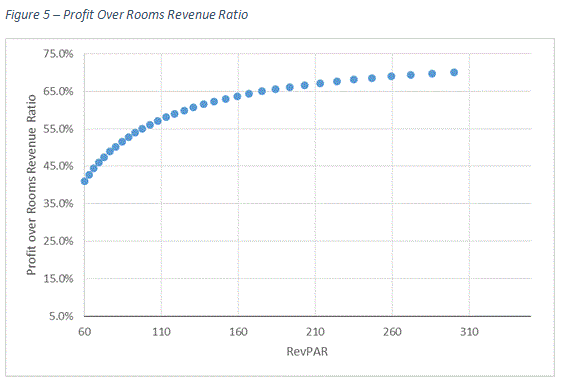
Figure 5 shows how profit margins, expressed as a percentage of rooms revenue, change when RevPAR increases. The curve shows that profit margin growth decelerates as RevPAR levels increase. This is understandable because, as we have illustrated, ProPAR growth rates become smaller as RevPAR levels increase. As ProPAR growth rates converge to the 5.0% RevPAR growth rate, a marginal profit becomes smaller, which stabilizes the profit ratio.
Impact of RevPAR Levels on Profit Growth
In the previous section we illustrated the decelerating nature of profit growth. A major implication of the result is that a hotel’s RevPAR level can help determine the degree to which profit growth can be induced by RevPAR growth.
Read full article at: Hotel Online

